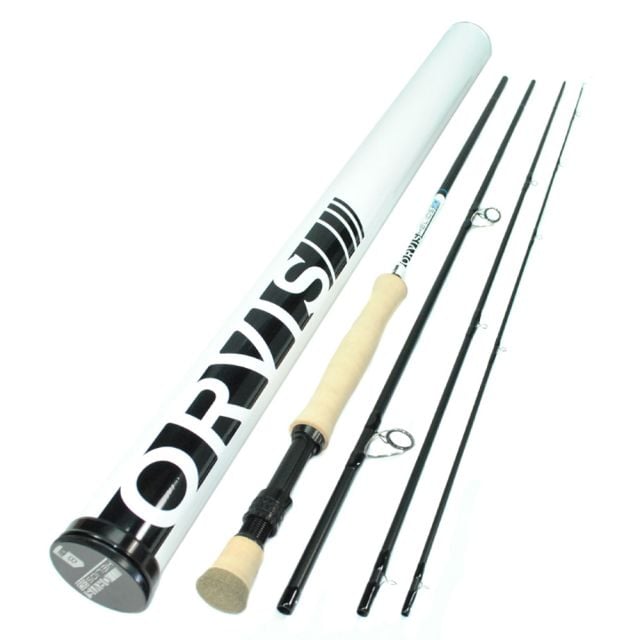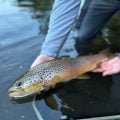“Eights Are Great”- 8-Weight Fly Rods Over and Under $500
Most anglers will agree that an 8-weight is probably the optimal rod for bonefish.
Our editors thought that a gear guide focused on 8-weight selection would be helpful for the spring. These are some rods that we feel are good buys—six rods priced over $500 and six rods priced under $500. Most of us would gladly fish with any rod in this selection.
Fly Rods Over $500

Sage Salt HD – KonneticHD Technology; Squid Ink blank color, black thread wraps with blue trim wraps; oversized Fuji ceramic stripper guides, oversized hard chromed snake guides and tip-top; integrated hidden hook keeper in reel seat; laser-etched line weight on slide band; aluminum rod tube. $950

Orvis Helios 3 – matte Midnight blank; reel seat is type III anodized aluminum Midnight Black w/matte Midnight carbon insert; blue accent wrap, black/black main wraps; REC recoil snake guides; SiC/titanium stripping guides; aluminum rod tube. $949

Thomas & Thomas Zone Fly Rod – Natural finish carbon appearance; clear anodized premium aluminum hardware; blue fiber reel seat hand rolled at T&T; composite reinforced premium-quality cork grips; titanium frame stripping guides with Zirconium inserts; Snake brand E-Coating universal snake guides; T&T Blue thread with silver accent wraps; aluminum rod tube. $545

Scott Radian– ReAct technology; FiberFuse enhanced resin system; Advanced Reinforced Carbon blanks; multi modulus fiber lay ups; natural finish; made entirely in USA. $795

Winston Air Salt – Hard chrome titanium-colored snake guides with nanolite stripping guides; stealth matte Winston Green finish; charcoal Gray uplocking reel seat, anodized aluminum with double locking rings and 1 ½” fighting butt; graphite rod tube with embroidered with logo rod sock. $975

G. Loomis CROSSCURRENT GLX – GLX graphite, Multi-Taper technology, REC Recoil fly guides. $690
Fly Rods Under $500

Orvis Clearwater – Blanks are black chrome with white accents; quick rod identifier on the blank; chrome snake and stripping guide with a ceramic insert; full black nickel aluminum reel seats; rods with fighting butts have composite tips for durability; gray rod tube; 25-Year Guarantee; designed in Vermont. $249

ECHO Boost – Four-piece travel design; lightweight, high-modulus graphite blank; fabric-covered square rod case & sock; corrosion-resistant titanium guides on standard models; wood insert reel seat for standard models. $249.99

Scott Tidal Fly Rod – X-Core technology, multi modulus fiber lay ups, natural finish, made in the USA. $495

Redington Crux Salt – Line Speed Taper; Angled Key Grip cork handle; anodized aluminium reel seat with in-built hook keeper; metallic olive matte finish; cordura rod tube with dividers
lifetime warranty. $399.99

ECHO Bad Ass Glass (B.A.G.) – Translucent Sky Blue; unique fiberglass rod tube; stainless guides w/ low-friction ceramic stripper; two grip styles; aluminum reel seat; Echo lifetime warranty. $279.99

TFO Axiom II Fly Rod – $339.95
ABOUT SALTWATER RODS
It’s easy to tell you what we like, but rod selection is far too intimate to leave to someone else. We thought it would be most helpful to remind you of the characteristics of a quality rod and let you come to your own conclusions.
Rod Action
What action rod you’ll prefer depends on the type of caster you are and what feels better to you. For single-handed rods, rod action is derived from the top half of the rod, while the bottom half provides the power. To put things simply, fast-action rods have softer tip sections that transition to a stiffer lower blank, while medium-action rods follow a smoother curve throughout the entire blank. Fast-action rods are ideal for anglers with “punchier” casting strokes and those able to readily change their hand speed in different fishing situations. If you don’t fit into either one of those categories, a fast-action rod may provide more tailing loops than fun. For many anglers, a medium- to medium-fast-action rod is the best bet.
Glass Versus Carbon Fiber
A few decades ago, fiberglass was the most prominent material for manufacturing fishing rods. These rods, constructed with E-glass, were heavy by today’s standards and didn’t offer the recovery speeds provided by modern manufacturing techniques. In the past few years, fiberglass rods have made a resurgence, albeit with a different type of glass. Today’s fiberglass rods are typically constructed with S-glass, which has a higher tensile strength and requires less material to achieve a desired stiffness. While still heavier and bulkier than their carbon-fiber counterparts, fiberglass rods have some very real benefits. Glass fibers elongate more readily, allowing rods to flex deep into the blank before breaking. This is the reason many seasoned shark and billfish anglers swear by fiberglass rods. From a pleasure standpoint, glass rods offer a more “soulful” fishing experience by virtue of their moderate actions, forcing the angler to slow down and take a breath from the often frenetic reality of standing on a casting platform for hours on end.
Carbon-fiber rods are always going to be lighter and more capable of lightning-fast shots to moving fish, but bonefishing doesn’t always require these characteristics. For folks with shoulder issues or those who plan on fishing from sunup to sundown, carbon fiber’s lower overall weight can be helpful in reducing strain and fatigue. If you’re fortunate enough to own a quiver of rods, having both glass and carbon-fiber options at hand will ensure you’ll have the right tool at the right time.
Color
Many rod companies manufacture their rods primarily in neutral gray, dark green, dark blue, or black. These are easy to match with a gunmetal or black reel, but they’re kind of boring. Fiberglass rods come in many colors and are some of the brighter rods on the flats. The reality is that color doesn’t really matter, and you should buy a rod based on how the it casts and how it feels to you (although we would like to see more sky-colored rods like the Echo’s Bad Ass Glass). This brings us to the most important point….
Feel
Buying a rod without casting it is like buying an expensive suit with out trying it on. One size does not fit all. If you place our team’s bonefish rods in a pile, there are many brands on the table, but even more opinions about them. That’s because each company makes different models, and they do not cast the same. One of our members did not like the Helios 2, but he won’t let go of his Helios 3. You have to try a rod before you buy it. If your fly shop offers this option, we recommend you get a loaner and actually fish with it before you decide.
Images Courtesy of ReelFlyRod











